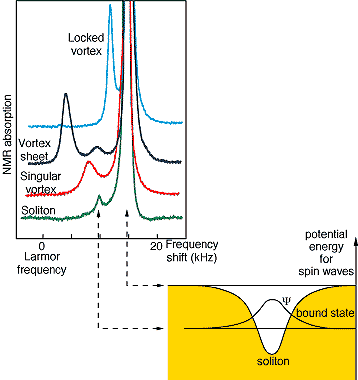Solitons in 3He-A
 Various topological objects and textures occur in superfluid
3He-A. The simplest of these are
solitons. They are domain-wall like structures where a planar object
separates two different but degenerate bulk states. Experimentally
solitons are detected via satellite peaks that appear in
the absorption
spectrum of nuclear magnetic resonance (NMR).
The frequencies of the peaks can be calculated by
solving a
Schrödinger-like equation for bound states in a potential caused
by the soliton.
We include dissipation by considering normal-superfluid conversion and spin
diffusion.
We compare the results with
experiments and discuss their implications on the basic parameters of
3He. The agreement with experiments is good except a puzzling
difference in the frequency of a splay soliton near the superfluid transition
temperature.
Various topological objects and textures occur in superfluid
3He-A. The simplest of these are
solitons. They are domain-wall like structures where a planar object
separates two different but degenerate bulk states. Experimentally
solitons are detected via satellite peaks that appear in
the absorption
spectrum of nuclear magnetic resonance (NMR).
The frequencies of the peaks can be calculated by
solving a
Schrödinger-like equation for bound states in a potential caused
by the soliton.
We include dissipation by considering normal-superfluid conversion and spin
diffusion.
We compare the results with
experiments and discuss their implications on the basic parameters of
3He. The agreement with experiments is good except a puzzling
difference in the frequency of a splay soliton near the superfluid transition
temperature.
A soliton forms the back-bone for a vortex sheet.
Other topological objects in 3He-A are
vortices and point defects.
Publications
Back to helium theory page
15.4.2003, Erkki Thuneberg,
Email
 Various topological objects and textures occur in superfluid
3He-A. The simplest of these are
solitons. They are domain-wall like structures where a planar object
separates two different but degenerate bulk states. Experimentally
solitons are detected via satellite peaks that appear in
the absorption
spectrum of nuclear magnetic resonance (NMR).
The frequencies of the peaks can be calculated by
solving a
Schrödinger-like equation for bound states in a potential caused
by the soliton.
We include dissipation by considering normal-superfluid conversion and spin
diffusion.
We compare the results with
experiments and discuss their implications on the basic parameters of
3He. The agreement with experiments is good except a puzzling
difference in the frequency of a splay soliton near the superfluid transition
temperature.
Various topological objects and textures occur in superfluid
3He-A. The simplest of these are
solitons. They are domain-wall like structures where a planar object
separates two different but degenerate bulk states. Experimentally
solitons are detected via satellite peaks that appear in
the absorption
spectrum of nuclear magnetic resonance (NMR).
The frequencies of the peaks can be calculated by
solving a
Schrödinger-like equation for bound states in a potential caused
by the soliton.
We include dissipation by considering normal-superfluid conversion and spin
diffusion.
We compare the results with
experiments and discuss their implications on the basic parameters of
3He. The agreement with experiments is good except a puzzling
difference in the frequency of a splay soliton near the superfluid transition
temperature.